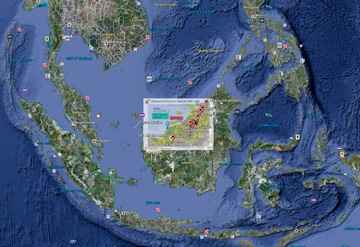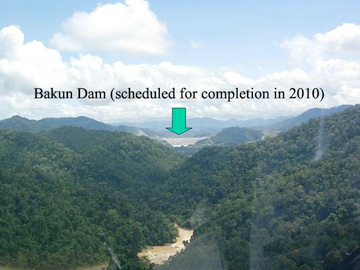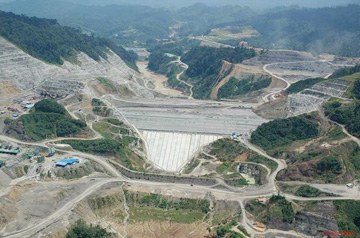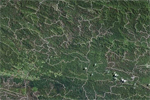Last October indigenous groups, local people, and domestic NGOs formed the Save Sarawak’s Rivers Network to fight the planned construction of a dozen dams in the Malaysian state on the island of Borneo. The coalition opposes the dam-building plans, known as the Sarawak Corridor of Renewable Energy (SCORE) initiative, due to its impacts on indigenous and river communities, the destruction of pristine rainforest, and the degradation of the state’s rivers.
“At the moment, there is no coordinated effort by the indigenous communities and civil societies to campaign against the construction of these destructive mega-dam projects. Therefore there is an urgent need to initiate a state, national and international campaign against these mega-dams,” Save Sarawak’s Rivers Network’s chairperson, Peter Kallang, said in a press conference this week as reported by Free Malaysia Today. He noted that of paramount importance was to reach out to those directly impacted by the dams.
   Bakun dam in Sarawak. For details see David Tryse’s Flooding Borneo’s rainforest: Sarawak’s confidential dam plans 2008-2020 [Google Earth KMZ file] |
Five foreign NGOs from the U.S. and EU have also announced support of the nascent coalition, including The Bruno Manser Fund, International Rivers, Borneo Project, Rainforest Action Network (US) and the Rainforest Foundation Norway.
After long delays and cost overruns, one of the dozen dams has already been completed, the 2,400 megawatt Bakun dam. The dam displaced around 10,000 indigenous people and flooded 70,000 hectares of rainforest.
While the Sarawak government has argued that the dams are needed to power the state, the Bakun dam alone produces more than double the power used by Sarawak at peak times. The additional power is likely to go to a planned aluminum smelter run by Cahaya Mata Sarawak (CMS) and Anglo-Australian mining giant Rio Tinto. Another dam, the 900 megawatt Murum dam, is currently under construction.
“The construction of the dams will not bring development to the people directly affected but it does bring severe and permanent damages to the whole environment and to the community at large,” Kallang said. “Development for the people must be for the immediate and above all, long term good of all the people and not just a few, who own shares in power generation and big corporations.”
Proponents of dam building have argued that they are “green” energy sources. However dams built in the tropics have been shown to release massive amounts of the methane, a greenhouse gas more potent than carbon dioxide, due to rotting vegetation trapped in the reservoir. A study last year found that a dam in Laos was still a significant source of greenhouse gases a decade after being built, emitting between 1.2 and 3.2 gigagrams of carbon annually. Another dam, however, was no longer a source of emissions after 40 years.
Save Sarawak Rivers will be holding a conference this week in Miri, including the presentation of papers by eight key speakers.
CITATION: Vincent Chanudet, Stéphane Descloux, Atle Harby, Håkon Sundt, Bjørn Henrik Hansen, Odd Brakstad, Dominique Serça, Frédéric Guerin. Gross CO2 and CH4 emissions from the Nam Ngum and Nam Leuk sub-tropical reservoirs in Lao PDR. Science of The Total Environment. Volume 409, Issue 24, 15 November 2011, Pages 5382-5391.
Related articles
Malaysian court blocks rainforest tribes’ fight against mega-dam in Borneo
(09/09/2011) Indigenous tribes in Borneo suffered a stinging defeat Thursday after Sarawak’s highest court ruled against them in 12-year-long legal battle. Tribal groups had challenged the Malaysian state government for seizing indigenous lands in order to build a massive hydroelectric power plant, dubbed the Bakun dam, but the three-person top court found unanimously against the tribes.
Rainforest tribe forcibly removed from dam area to palm oil plantation
(06/23/2011) A thousand Penan indigenous people have been forcibly moved from their rainforest home to monoculture plantations, reports Survival International. To make way for the Murum dam, the Malaysian state government of Sarawak is moving a thousand Penan from their traditional homes, but as apart of the deal the government promised to move the Penan to another part of their ancestral land. The government has since sold that land to a palm oil company, which is currently clearcutting the forests for plantations.
Report: corruption in Sarawak led to widespread deforestation, violations of indigenous rights

(03/10/2011) At the end of this month it will be 30 years since Abdul Taib Mahmud came to power in the Malaysian state of Sarawak. Environmentalists are using the occasion, along with new revelations, to highlight corruption and nepotism they say have characterized his regime. Chief Minister Taib and his decades-long administration are no strangers to such allegations, but a new report from the indigenous-rights group Bruno Manser Fund (BMF)—amid criticism from independent media sources, such as Sarawak Report and Radio Free Sarawak—are adding fuel to the fire. Most recently, the report describes in great detail how the tropical timber trade in Sarawak has undercut indigenous groups while toppling some of the world’s greatest rainforests, all at the expense of the Sarawak people.